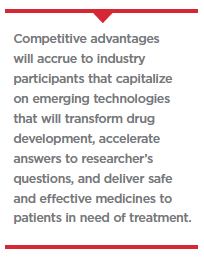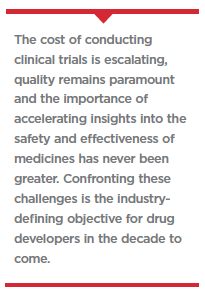 The biopharma industry faces myriad challenges in the pursuit of its mission to bring new treatments to patients in need of cures, chief among them the “Iron Triangle" of time, cost, and quality with respect to clinical research. The cost of conducting clinical trials is escalating, quality remains paramount and the importance of accelerating insights into the safety and effectiveness of medicines has never been greater. Confronting these challenges is the industry-defining objective for drug developers in the decade to come. The importance of this undertaking cannot be overstated when we consider the afflicted patient populations that are waiting on us to deliver efficacious and safe treatments.
The biopharma industry faces myriad challenges in the pursuit of its mission to bring new treatments to patients in need of cures, chief among them the “Iron Triangle" of time, cost, and quality with respect to clinical research. The cost of conducting clinical trials is escalating, quality remains paramount and the importance of accelerating insights into the safety and effectiveness of medicines has never been greater. Confronting these challenges is the industry-defining objective for drug developers in the decade to come. The importance of this undertaking cannot be overstated when we consider the afflicted patient populations that are waiting on us to deliver efficacious and safe treatments.
Technology Breakthroughs Key to Transforming Clinical Research
The obstacles have been unyielding and the solutions have been slow to gain traction, however, now more than ever, breakthroughs in technology hold the promise of transforming clinical research. Technological advancements in data interoperability are rapidly making an impact today, fueled by the network effect of data and partnerships. Advancements in virtualized research are being driven by a focus on patient-centricity, “natural" smart interfaces, and an ever-expanding list of devices that are always present, always connected, continually getting smarter, and have access to next generation networks with an unimaginable amount of  information and technology services. Intelligent architectures and real-world data infrastructures are allowing for the creation of core technology platforms that bring together a diverse, complex, and disruptive set of technology capabilities. Real-world data infrastructures are purpose-built with the sole focus of disrupting and modernizing critical domains of research and drug development. Designed upon a foundation of cognitive computing, artificial intelligence thru machine learning and augmented intelligence is empowering clinical experts through automation, data-driven decision making, and various stages of intelligence — assisted, augmented, and autonomous. Innovative solutions in the areas of study design, patient identification, data collection, and evidence generation will significantly impact drug development and enable realization of the vision set forth in the 21st Century Cures Act and subsequent FDA Framework for Real World Evidence.
information and technology services. Intelligent architectures and real-world data infrastructures are allowing for the creation of core technology platforms that bring together a diverse, complex, and disruptive set of technology capabilities. Real-world data infrastructures are purpose-built with the sole focus of disrupting and modernizing critical domains of research and drug development. Designed upon a foundation of cognitive computing, artificial intelligence thru machine learning and augmented intelligence is empowering clinical experts through automation, data-driven decision making, and various stages of intelligence — assisted, augmented, and autonomous. Innovative solutions in the areas of study design, patient identification, data collection, and evidence generation will significantly impact drug development and enable realization of the vision set forth in the 21st Century Cures Act and subsequent FDA Framework for Real World Evidence.
Data Interoperability & Network Effect
In a recent speech, the new acting FDA Commissioner Dr. Ned Sharpless issued a challenge to industry: “If we want to harness the full potential of therapies to transform care, we need to become more efficient, more collaborative, and more data driven so that we can learn from every patient’s journey1." In the years ahead, healthcare data interoperability will play a lead role in meeting the commissioner’s and the larger market’s challenge. New technologies and solutions in this arena allow us to profoundly enrich what we know about a patient profile, their clinical encounters and the outcomes in ways that were not possible to address, or, were cost-prohibitive in the past.
Combining and enriching traditional randomized controlled clinical trial data with real-world data sources (EHR, health information exchanges, integrated delivery networks, claims, labs, genomics, data markets, sensors, devices, wearable, etc.) enable insights that are not feasible using traditional data collection methods. This in turn increases the reliability and value of the study data and meaningful inferences, leading to a better understanding of real-world patient outcomes. Real- world data exists in many forms and is available from many sources (e.g. integrations, partnerships, commercial availability); however, finding and acquiring this data is only the beginning. Maximum value is achieved by linking data from these disparate data sources at the patient level to form a single comprehensive dataset. Advanced analytics, simulations, and statistically driven data visualization — powered by unsupervised learning techniques can then mine for relationships and insights that would never appear were the datasets analyzed independently.
world data exists in many forms and is available from many sources (e.g. integrations, partnerships, commercial availability); however, finding and acquiring this data is only the beginning. Maximum value is achieved by linking data from these disparate data sources at the patient level to form a single comprehensive dataset. Advanced analytics, simulations, and statistically driven data visualization — powered by unsupervised learning techniques can then mine for relationships and insights that would never appear were the datasets analyzed independently.
The ubiquitous digitization of the healthcare data landscape presents untapped opportunities to reduce the cost of research while simultaneously improving quality and reliability via a wide range of use cases — from centralized identification and recruitment of both sites and subjects to automated population of CRF forms. Interoperability with the systems HCPs use every day (e.g. pushing study-related reminders or flagging patients as potential subjects) can streamline site engagement. Efficiencies like these not only reduce the cost of clinical research: they reduce the burden on sites, thereby increasing their willingness to participate.
These solutions introduce transformative improvement to the availability, breadth, depth, accuracy, and velocity of data collection. Clinical trials and non-interventional research approaches are enriched through the efficient acquisition and intelligent processing of RWD from medical/pharmacy claims, lab data, wearables, biomarkers, and other sources.
Virtualized Research
Healthcare data digitization sets the stage for patients to have greater access to and ownership of their healthcare records than ever before. The network effect of these partnerships and data interoperability standards will catalyze the movement toward virtualized trial designs; fueled through modernized approaches to rapid feasibility, appropriate patient identification and segmentation for protocol specific goals, enrollment, engagement, and multi-modal collection of patient-generated data throughout the clinical trial lifecycle. The traditional approach of “bringing the patient to the study" at brick-and-mortar facilities will be augmented and replaced by tactics that “bring the study to the patient."
Virtualized clinical trials, registries, and other observational initiatives represent another critical and relatively inexpensive source of research data, which is collected directly from patients. The explosion of IoT, mobile devices, and wearables mean that the average human in the developed world walks around with both an ever-increasing array of physical-world sensors and an engagement platform that is nearly impossible to ignore.
Chatbots powered by cutting-edge AI engage patients in conversation over channels with which the patient is already comfortable (e.g. SMS, social media chat) in order both to collect data and to guide the patient through the protocol.
These intelligent interfaces and other IoT enabled home medical devices (e.g. EKG sensors) are also becoming more common as telemedicine gains traction. Inclusion of these devices will form an increasingly critical part of protocol design, especially as pending and ongoing legislation facilitates and allows for this information to serve as part of the body of the submission for regulatory approval and managed market access consideration related to value of the product versus the cost of care.
Real-World Data Infrastructure Powered by AI
The automated transformation of disparate and unstructured real-world data into high-quality research-grade datasets holds great promise when it comes to delivering life-changing cures faster and cheaper, albeit with significant obstacles. Integrating with different systems at each site has historically been cost prohibitive due to disparate and competing data standards. Forces within healthcare are beginning to pull individual EHR implementations out of their silos and into interconnected networks, which act as both an exchange for health data as well as a single point of integration. Patient data privacy concerns can derail attempts to link datasets, however, de-identification solutions utilizing identity hashing algorithms enable linking patient data with a high degree of confidence without ever needing to expose personally identifiable information. Data ownership will continue to be an important piece of the puzzle, as, PHI and other privacy concerns related to data access, and, the “empowered patient" start to influence study participation and data liquidity.
Whereas healthcare data is mostly digitized, the data is often only partially structured. However, as cloud technologies democratize machine learning, natural language understanding (NLU) promises to free data points locked in narrative text, voice and other unstructured formats. Armed with semantic understanding and deep and expressive ontologies, these algorithms will be able to create research grade datasets through cognitive AI processing. Augmented intelligence powered by machine learning capabilities and big data will empower clinical experts to make faster and better decisions.
Conclusion
As solutions emerge, it will be critical that biopharma companies select partners that are invested in the clinical expertise, the technologies and the relationships across the healthcare delivery system needed to navigate this dynamic and complex landscape. The data network effect along with the partnership network effect will make it more critical than ever to select core partners that are strategic inflection points. Expertise and core competencies across a wide range of technical domains are essential attributes to target as drug developers form these mission critical collaborations. Competitive advantages will accrue to industry participants that capitalize on these emerging technologies that will transform drug development, accelerate answers to researcher’s questions, and deliver safe and effective medicines to patients in need of treatment.(PV)
Editor’s Note: 1 Dr. Ned Sharpless, “Remarks to the 2019 FDLI Annual Conference" (FDLI Annual Conference, Washington, DC, May 2, 2019).
UBC partners with the biopharmaceutical industry to provide leading late-stage and patient support services focused on patient safety, access, and value.
For more information, visit ubc.com.


















